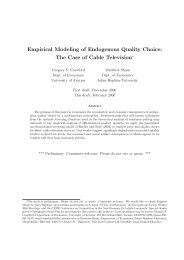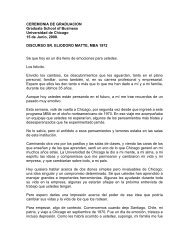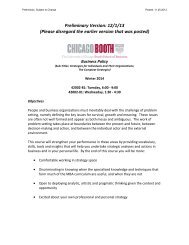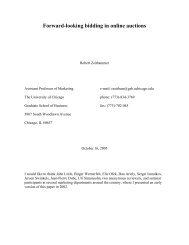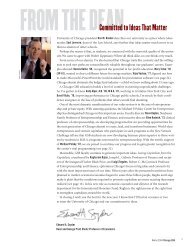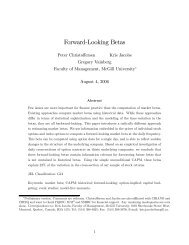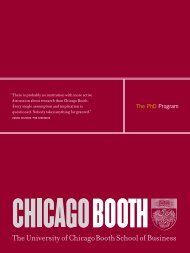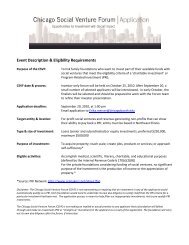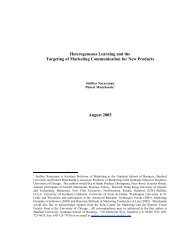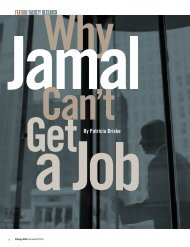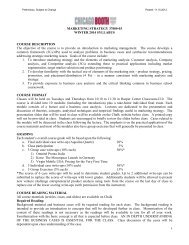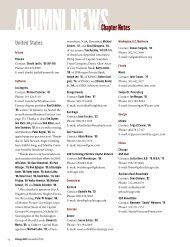How VCs Choose Entrepreneurs - The University of Chicago Booth ...
How VCs Choose Entrepreneurs - The University of Chicago Booth ...
How VCs Choose Entrepreneurs - The University of Chicago Booth ...
You also want an ePaper? Increase the reach of your titles
YUMPU automatically turns print PDFs into web optimized ePapers that Google loves.
FEATURE FACULTY RESEARCH<br />
<strong>The</strong> Art <strong>of</strong><br />
the Deal—<br />
<strong>How</strong> <strong>VCs</strong> <strong>Choose</strong> <strong>Entrepreneurs</strong><br />
For more than a decade, academic research has postulated<br />
the way entrepreneurs and venture capitalists interact. But<br />
has financial contracting theory borne any resemblance<br />
to what happens in the real world? Using data provided by<br />
a pool <strong>of</strong> successful <strong>VCs</strong> that include GSB alumni, Steven N.<br />
Kaplan and Per Stromberg have come up with two studies that<br />
answer the question. By Patricia Briske Photos by Kevin Weinstein<br />
22 <strong>Chicago</strong> GSB Summer/Fall 2002<br />
Summer/Fall 2002 <strong>Chicago</strong> GSB 23
FEATURE FACULTY RESEARCH<br />
For years, financial contracting theories have focused on the way both sides should act. In many<br />
instances, however, the theories went awry because they didn’t have a clear understanding <strong>of</strong> actual<br />
practice. Kaplan, Neubauer Family Pr<strong>of</strong>essor <strong>of</strong> <strong>Entrepreneurs</strong>hip and Finance, and Stromberg,<br />
associate pr<strong>of</strong>essor <strong>of</strong> finance, looked at the contractual agreements between <strong>VCs</strong> and entrepreneurs,<br />
then at the players themselves and how they interact.<br />
After reviewing more than two hundred<br />
agreements between actual principals and<br />
investors, the researchers have written a<br />
detailed description <strong>of</strong> the interactions and<br />
have made progress toward explaining them.<br />
“<strong>The</strong>re’s a perception among entrepreneurs<br />
that <strong>VCs</strong> are stealing your company,” Kaplan<br />
said. “But they’re not. <strong>The</strong> way contracts<br />
are set up is that they state, ‘If the entrepreneur<br />
delivers what’s promised, the entrepreneur<br />
will do well.’ If that’s what happens, the VC<br />
will leave you alone.”<br />
Gerald Gallagher, ’69, agreed with their<br />
conclusion. “We don’t want entrepreneurs<br />
to feel abused, to get two years down the<br />
road and say, ‘Hey, this isn’t fair.’ As a VC,<br />
you’re building a base for a long-term<br />
relationship,” he said. A general partner at<br />
Oak Investment Partners in Minneapolis,<br />
Per Stromberg (left) and Steven Kaplan based their research on actual contracts between venture<br />
capitalists and entrepreneurs, many <strong>of</strong> them GSB alumni.<br />
Gallagher is among the <strong>VCs</strong> who are familiar<br />
with Kaplan and Stromberg’s research.<br />
Guy Nohra, ’89, a general partner with Alta<br />
Partners in San Francisco who read the<br />
studies, echoed the sentiment. “<strong>The</strong> savvy<br />
entrepreneur will understand it’s a necessary<br />
evil to give up control, meaning to give up<br />
more than 50 percent <strong>of</strong> the company. <strong>The</strong>re’s<br />
a saying: ‘You can own 100 percent <strong>of</strong> zero<br />
or 10 percent <strong>of</strong> $1 billion. You choose.’”<br />
<strong>The</strong> wide variety <strong>of</strong> agreements that were<br />
struck was one feature <strong>of</strong> the business that<br />
Kaplan and Stromberg didn’t expect to find.<br />
“<strong>The</strong> richness <strong>of</strong> the contracts surprised<br />
us,” Kaplan said. It also surprised the investors<br />
who had provided the data for the research.<br />
“<strong>The</strong> investors each did things in a particular<br />
way, and they didn’t realize others did it<br />
very differently,” Kaplan said.<br />
Put It in Writing<br />
Kaplan and Stromberg’s first paper,<br />
“Financial Contracting <strong>The</strong>ory Meets the<br />
Real World: An Empirical Analysis <strong>of</strong><br />
Venture Capital Contracts,” studied 213<br />
contracts in 119 companies financed by<br />
14 venture capital firms. Each VC turned<br />
over the agreements signed during each<br />
round <strong>of</strong> financing and, when possible,<br />
the entrepreneur’s business plan, internal<br />
analyses <strong>of</strong> the investment, and data on<br />
subsequent performance.<br />
What the researchers discovered was<br />
that each round <strong>of</strong> funding allows <strong>VCs</strong><br />
to allocate various rights separately, based<br />
on observable measures <strong>of</strong> performance.<br />
“In general, board rights, voting rights, and<br />
liquidation rights are allocated such that<br />
if the firm performs poorly, the <strong>VCs</strong> obtain<br />
full control,” Kaplan and Stromberg wrote.<br />
“As performance improves, the entrepreneur<br />
retains or obtains more control rights. If<br />
the firm performs very well, the <strong>VCs</strong> retain<br />
their cash flow rights but relinquish most<br />
<strong>of</strong> their control and liquidation rights.”<br />
<strong>The</strong>y also noted that <strong>VCs</strong> commonly<br />
include noncompete clauses and vesting<br />
provisions in the agreement to make it<br />
more costly for the entrepreneur to leave the<br />
firm. And, Kaplan and Stromberg discovered,<br />
when <strong>VCs</strong> have voting rights and a board<br />
majority, they’re more likely to release funds<br />
based on performance milestones.<br />
<strong>VCs</strong> ask a lot, but they bring much more<br />
to the table than a standard investor does.<br />
“<strong>VCs</strong> add value beyond what regular investors<br />
can do,” Kaplan said. “When it comes to<br />
advising and monitoring the CEO, the VC<br />
will be more involved than a banker.”<br />
This increased involvement sometimes<br />
means educating the entrepreneurs. Gallagher<br />
recalled an instance in which an entrepreneur<br />
discussed merger and acquisition possibilities<br />
with someone outside the firm before<br />
talking to the board <strong>of</strong> directors about it.<br />
“On a fairly regular basis, the CEO will do<br />
something without consulting the board<br />
because it’s his first time through,” he said.<br />
And it’s not uncommon for a venture<br />
capitalist to be the one who draws the<br />
line between acting as a board member and<br />
acting as a manager. “Other than when<br />
you’re dealing with a governance issue, the<br />
VC should serve as a consultant, giving an<br />
opinion,” Gallagher said. “But you have to<br />
be very careful about not interfering with<br />
management—even if they ask you to.”<br />
Kaplan also pointed out that investors<br />
have very specific ways <strong>of</strong> participating.<br />
“<strong>VCs</strong> get different securities—convertible<br />
preferred stock versus common stock,<br />
which is what entrepreneurs get. <strong>The</strong>y also<br />
have rights to control the board. But if<br />
things go well, the special rights go away. If<br />
they don’t, the <strong>VCs</strong> can exert their power.”<br />
Character Counts<br />
In their second paper, “Characteristics, Contracts,<br />
and Actions: Evidence from Venture<br />
Capitalist Analyses,” Kaplan and Stromberg<br />
analyzed investment memoranda from 11<br />
venture capital partnerships in 67 companies<br />
to describe the characteristics and risks<br />
that <strong>VCs</strong> consider in actual deals. <strong>VCs</strong> provided<br />
the researchers with the investment<br />
memorandum—from brief two-page writeups<br />
to detailed descriptions—that the entire<br />
partnership group used to decide whether<br />
“<strong>The</strong>re’s a perception among entrepreneurs<br />
that <strong>VCs</strong> are stealing your company.”<br />
—Steven N. Kaplan<br />
to make the investment. Most start-ups<br />
were in information technology and s<strong>of</strong>tware,<br />
but the sample also included biotechnology,<br />
telecommunications, health care, and retail<br />
ventures. <strong>The</strong> researchers took note <strong>of</strong> how<br />
the data came into play when <strong>VCs</strong> set up<br />
the financial contracts and how the investors<br />
monitored the firms over time.<br />
Kaplan and Stromberg found that <strong>VCs</strong><br />
evaluated the opportunity and also considered<br />
the management team. “<strong>The</strong>y ask, ‘Does<br />
the entrepreneur have a good idea? Is there<br />
a big market? Does the business model<br />
make sense? Can they beat the competition?<br />
24 <strong>Chicago</strong> GSB Summer/Fall 2002<br />
Summer/Fall 2002 <strong>Chicago</strong> GSB 25
FEATURE FACULTY RESEARCH<br />
Will the customers buy it?’ That’s the opportunity,”<br />
Kaplan said.<br />
When it comes to the management team,<br />
however, Kaplan and Stromberg said entrepreneurs<br />
<strong>of</strong>ten meet with potential investors<br />
even when their team is short a few members.<br />
“When investors go to meet with them, they<br />
find out the team is not complete,” Stromberg<br />
said. And in their paper, they write, “<strong>VCs</strong><br />
play a large role in shaping and recruiting the<br />
senior management team. In at least half<br />
<strong>of</strong> the investments, the VC expects to play an<br />
important role in recruiting management.”<br />
Gallagher agreed. “We’re frequently<br />
involved in helping the CEO pick the senior<br />
people,” he said. “Experienced <strong>VCs</strong> should<br />
know about selecting people because we’ve<br />
had a lot <strong>of</strong> experience.”<br />
<strong>VCs</strong> also have certain expectations <strong>of</strong><br />
the entrepreneur at the helm. Stromberg said,<br />
“You look to see how much experience he<br />
or she has, whether they’re focused. You look<br />
for frugality because you don’t want to give<br />
$2 million to someone who’s going to go <strong>of</strong>f<br />
and just waste it.”<br />
When it comes time to draft the contractual<br />
agreement, the more uncertainty <strong>VCs</strong> face,<br />
the greater control they seek in the venture.<br />
“One problem arises when the investor doesn’t<br />
know what the entrepreneur is thinking,”<br />
Kaplan said. “That’s known as adverse selection.<br />
<strong>The</strong> other problem is that after he’s<br />
given the entrepreneur some money, the VC<br />
doesn’t know what the guy’s doing with it.<br />
That’s called moral hazard.”<br />
<strong>How</strong> these decisions play out in the<br />
long run is hard to say, though. When the<br />
researchers tracked the success <strong>of</strong> this<br />
sample <strong>of</strong> 67 firms, Kaplan said, “A fourth <strong>of</strong><br />
them have gone public, another fourth have<br />
been liquidated, and on about half <strong>of</strong> them,<br />
the jury’s still out. But,” he pointed out,<br />
“you wouldn’t expect everyone to succeed.”<br />
Still, studying successful companies has<br />
value, Kaplan and Stromberg wrote. “If anything,<br />
a bias toward more successful <strong>VCs</strong><br />
would be helpful because we are more likely<br />
to have identified the methods used by<br />
sophisticated, value-maximizing principals.”<br />
What Makes a Good Entrepreneur<br />
“[Good entrepreneurs have] a lot <strong>of</strong> experience<br />
in that industry. <strong>The</strong>y’ve been a successful<br />
entrepreneur before,” Kaplan said. “Having<br />
a complete team is important; so if you’ve got<br />
one good person, can you fill it out?”<br />
Having a good grasp <strong>of</strong> the financial situation<br />
is equally important, Stromberg added.<br />
“Frugality and being able to realistically budget<br />
and forecast is pretty important.” That<br />
“<strong>The</strong> inability [<strong>of</strong> entrepreneurs] to forecast<br />
financial progress is a relatively common<br />
complaint <strong>of</strong> <strong>VCs</strong>.”—Per Stromberg<br />
quality is <strong>of</strong>ten absent, he said. “<strong>The</strong> inability<br />
to forecast financial progress is a relatively<br />
common complaint <strong>of</strong> <strong>VCs</strong>.”<br />
When it comes to personality traits and<br />
abilities among entrepreneurs, Gallagher looks<br />
for four specific qualities. “<strong>The</strong>y’ll need<br />
intelligence because, unlike corporate CEOs,<br />
entrepreneurs won’t be surrounded by<br />
experienced staff and will <strong>of</strong>ten be dealing<br />
with stuff they’ve never seen before. Resourcefulness<br />
is important because an entrepreneur<br />
may have a great idea but not have<br />
the time or capital. <strong>The</strong>y have to be openminded<br />
because they may have to deal with<br />
situations that are different than they’d anticipated;<br />
for example, the competition may<br />
be tougher than they thought. <strong>The</strong>y have to<br />
search for ways to improve their company<br />
regardless <strong>of</strong> the source <strong>of</strong> the idea, and that<br />
includes what their competitors are doing. And<br />
they’ll have to have an inner self-confidence,<br />
because the whole team will draw strength<br />
from that,” Gallagher said.<br />
“If an entrepreneur isn’t open-minded,<br />
we usually have to replace that person.”<br />
Nohra listed similar qualities. “A good<br />
entrepreneur is motivated, aggressive, very<br />
bright, and focused. But,” he cautioned,<br />
“those same qualities can work against you,<br />
too. For instance, stubbornness—misguided<br />
motivation—is not good when you’re wrong.<br />
And the odds are so stacked against you, you<br />
almost have to be unrealistically optimistic.”<br />
Kaplan and Stromberg came up with<br />
their own ideas <strong>of</strong> what makes an entrepreneur<br />
successful. “<strong>VCs</strong> are going to do a<br />
lot <strong>of</strong> due diligence,” Kaplan said. “And<br />
you’d better have a management team made<br />
up <strong>of</strong> the right people who can do what<br />
they say they’re going to do. In terms <strong>of</strong> the<br />
opportunity, you’ve got to nail down answers<br />
to questions like, ‘Is it a big enough market<br />
to be attractive? Is it something customers<br />
are going to buy?’ ”<br />
<strong>The</strong> research also gives entrepreneurs a<br />
strong sense <strong>of</strong> what to expect in a contract.<br />
“It helps if you can look at them in a rational<br />
way. In one instance, we had a guy who<br />
was negotiating with venture capitalists.<br />
Before he read our paper, he thought, ‘This<br />
is awful. <strong>How</strong> can they do this? It’s outrageous,’<br />
” Kaplan recalled. “<strong>The</strong>n he read our<br />
paper and said, ‘OK, now I understand why<br />
they’re doing that; it makes sense. And here’s<br />
where I can negotiate.’ Or, ‘<strong>The</strong>re’s nothing<br />
I can do; this is the way it is.’”<br />
Stromberg said, “<strong>Entrepreneurs</strong> can also<br />
say, ‘Here’s where I’m getting a particularly<br />
bad deal, compared to the average guy.’”<br />
GSB students have access to the research<br />
if they take Kaplan’s course, Entrepreneurial<br />
Finance and Private Equity. “I teach how to<br />
evaluate the deal, which is based on paper<br />
number two. I also go over how you should<br />
negotiate the contract, and that’s based on<br />
paper number one. I hand them out,” Kaplan<br />
said. Teaching also gave Kaplan access to the<br />
venture capitalists who ultimately provided<br />
the data for the research.<br />
Kaplan and Stromberg’s next step is to<br />
see how their theories hold up internationally.<br />
<strong>The</strong>y collected data from companies in 16<br />
countries. “<strong>The</strong> U.S. clearly has been at the<br />
maximum in terms <strong>of</strong> entrepreneurial activity<br />
and venture capital. Is that because <strong>of</strong> the<br />
legal environment or the tax situation? Can<br />
you write similar contracts in other countries,<br />
Faculty Work is Available Online<br />
• For research on the Internet’s effect on commerce by Austan D. Goolsbee,<br />
pr<strong>of</strong>essor <strong>of</strong> economics, go to gsbadg.uchicago.edu/vitae.htm.<br />
• For work on strategies and innovation, particularly in high-tech industries,<br />
by Toby Stuart, Fred G. Steingraber–A.T. Kearney Pr<strong>of</strong>essor <strong>of</strong> Organizations<br />
and Strategy, go to gsbwww.uchicago.edu/fac/toby.stuart/research/.<br />
• For additional research by Kaplan, go to gsbwww.uchicago.edu/fac/<br />
steven.kaplan/research/.<br />
For additional research by Stromberg, go to gsbwww.uchicago.edu/fac/<br />
per.stromberg/research/.<br />
or are there impediments? If you can, then<br />
you predict there will be more entrepreneurship,”<br />
Kaplan said.<br />
Regardless <strong>of</strong> all the variables—the kind <strong>of</strong><br />
start-up, the experience <strong>of</strong> the entrepreneur,<br />
the contingencies in the contract—every<br />
agreement comes down to the same thing,<br />
Kaplan said.<br />
“All you need is two people to agree.”<br />
26 <strong>Chicago</strong> GSB Summer/Fall 2002<br />
Summer/Fall 2002 <strong>Chicago</strong> GSB 27
COVER STORY ENTREPRENEURSHIP<br />
AWINNINGVENTURE<br />
$7 MILLION POLSKY GIFT GIVES CHICAGO GSB AN ENTREPRENEURIAL EDGE<br />
<strong>Entrepreneurs</strong>, Present and Future: <strong>The</strong> GSB has given an edge to (from<br />
left) Michael P. Polsky, ’87, as well as New Venture Challenge participants<br />
Jeremy Graff, Peter Stratil, David Knoepfle, and Linda Zabors, ’02.<br />
By Patricia Briske with Amy Rust<br />
Photo credits: (left to right) Kevin Weinstein, Nathan Mandell, Nathan Mandell<br />
<strong>The</strong> Maroon Biotech team wasted<br />
no time getting down to business<br />
at the New Venture Challenge. <strong>The</strong>y<br />
had 35 minutes to convince a panel<br />
<strong>of</strong> seasoned venture capitalists that<br />
they deserved $20,000 in seed money<br />
for a new drug, and the competition<br />
was intense.<br />
<strong>The</strong> group <strong>of</strong> students from the GSB,<br />
the Law School, and the Pritzker School<br />
<strong>of</strong> Medicine wanted funding to create<br />
Poloxafuse, which could be used to<br />
heal cell membranes in patients who<br />
had suffered a stroke or heart attack.<br />
“We’re not the first ones to discover<br />
the drug, but we’ll combine it with<br />
a proprietary product,” explained GSB<br />
student David Knoepfle. In 15 minutes,<br />
he described the debut <strong>of</strong> a similar<br />
drug and why it failed, the market for<br />
Maroon Biotech’s product, and why<br />
it would take $5 million to bring<br />
Poloxafuse to the patients who need<br />
it. Its inventor, Rafael Lee, M.D., <strong>of</strong><br />
the <strong>University</strong> <strong>of</strong> <strong>Chicago</strong> Hospitals,<br />
and Maroon Biotech chairman Richard<br />
Egen sat silently nearby.<br />
<strong>The</strong>n the questioning began.<br />
“<strong>How</strong> far along are you in formulation?”<br />
asked Karen Kerr, Ph.D. ’95<br />
(physical chemistry), managing director<br />
<strong>of</strong> ARCH Venture Partners.<br />
“What’s your strategy for convincing<br />
the payer that this is a worthwhile<br />
thing?” asked John Oxaal, ’81, partner<br />
at Sevin Rosen Funds. Other pointed<br />
questions followed about marketing<br />
rights and winning FDA approval.<br />
Being able to field such tough<br />
questions is the key to winning the<br />
New Venture Challenge. For students<br />
with an eye on entrepreneurship,<br />
the annual business plan competition<br />
sponsored by Edward L. Kaplan, ’70,<br />
founder <strong>of</strong> Zebra Technologies, is<br />
the culmination <strong>of</strong> at least half a<br />
school year’s work. <strong>The</strong> courses, lab<br />
sessions, and leadership programs<br />
had prepared them for this moment.<br />
“<strong>The</strong>re’s a big difference between<br />
the first presentation we ever made<br />
in class and what we did today,”<br />
Knoepfle said. “<strong>The</strong> transformation<br />
is worth the cost <strong>of</strong> tuition.”<br />
<strong>The</strong> New Venture Challenge<br />
is one piece <strong>of</strong> the entrepreneurship<br />
program. <strong>Chicago</strong> GSB is<br />
taking its newest—and biggest—<br />
step toward training tomorrow’s<br />
entrepreneurs by establishing<br />
the Michael P. Polsky Center for<br />
<strong>Entrepreneurs</strong>hip. Named for Michael<br />
P. Polsky, ’87, founder <strong>of</strong> Invenergy,<br />
the center will help the GSB forge<br />
a future in the study, teaching, and<br />
practice <strong>of</strong> entrepreneurship.<br />
<strong>The</strong> center is made possible in<br />
part through a $7 million gift from<br />
Polsky, which brings the GSB closer<br />
to its campaign goal <strong>of</strong> $15 million<br />
for entrepreneurship. <strong>The</strong> endowment<br />
provides the financial security<br />
to keep existing programs in place<br />
and explore new programs, said dean<br />
Edward A. Snyder.<br />
28 <strong>Chicago</strong> GSB Summer/Fall 2002<br />
Summer/Fall 2002 <strong>Chicago</strong> GSB 29
COVER STORY ENTREPRENEURSHIP<br />
“This generous gift gives the GSB<br />
the backing to <strong>of</strong>fer students both the<br />
latest research from top faculty and<br />
real-world experience in entrepreneurship<br />
that is unmatched by any other<br />
business school,” he said.<br />
Entrepreneurial Edge<br />
Establishing the Michael P. Polsky<br />
Center for <strong>Entrepreneurs</strong>hip marks a<br />
crucial step in the entrepreneurship<br />
program’s expansion, bringing together<br />
the kinds <strong>of</strong> resources and services<br />
that centers like the Kilts Center for<br />
Marketing afford their students and<br />
faculty.<br />
Since 1998, the GSB’s entrepreneurship<br />
program has <strong>of</strong>fered students<br />
coursework that gives them a practical<br />
foundation, opportunities for realworld<br />
experience, and a network <strong>of</strong><br />
successful alumni who guide them—<br />
and sometimes <strong>of</strong>fer financial backing.<br />
<strong>The</strong> program’s strength lies in<br />
its faculty, which includes top entrepreneurial<br />
researchers as well as practitioners.<br />
Steven N. Kaplan, Neubauer<br />
Family Pr<strong>of</strong>essor <strong>of</strong> <strong>Entrepreneurs</strong>hip<br />
and Finance, is faculty director. He’s<br />
known for his insightful research, but<br />
it’s Kaplan’s work in the classroom<br />
that earned him a place on Business-<br />
Week’s list <strong>of</strong> top entrepreneurial<br />
faculty in 1995. James Schrager, clinical<br />
pr<strong>of</strong>essor <strong>of</strong> entrepreneurship, also<br />
made the list. Students value the fact<br />
“When you get out in the world and<br />
have to apply these things, they don’t<br />
always work the way you think they’re<br />
going to work.”—Ellen Rudnick<br />
that he works in the field heading up<br />
boards <strong>of</strong> directors, advising start-ups,<br />
and advising entrepreneurs.<br />
<strong>The</strong> Entrepreneurial Finance and<br />
Private Equity class is the bedrock<br />
<strong>of</strong> the curriculum. “It’s a case-based<br />
course oriented toward things that<br />
are useful in the real world,” Kaplan<br />
said. “We give students the frameworks<br />
and analytical tools to think about<br />
start-ups in the case-oriented courses.”<br />
Another popular course is New<br />
Venture Strategy, which Schrager<br />
teaches. Students come up with fresh<br />
business prospects, then research, develop,<br />
and present the venture to their<br />
classmates. <strong>The</strong> course is unique to<br />
<strong>Chicago</strong> GSB, Schrager said. “We’ve<br />
viewed entrepreneurial strategy as<br />
a separate discipline for a long time.<br />
Small businesses play in a different<br />
strategy arena than existing large<br />
businesses,” he said.<br />
GSB students on the Maroon<br />
Biotech team were glad to take Commercializing<br />
Innovation with clinical<br />
pr<strong>of</strong>essor <strong>of</strong> entrepreneurship Scott<br />
Meadow because <strong>of</strong> his 20-year career<br />
in venture capital. Drawing upon<br />
cases from actual companies, students<br />
“look at how the skills <strong>of</strong> marketing,<br />
manufacturing, strategy, and organizational<br />
behavior can be used within<br />
an entrepreneurial environment—<br />
particularly within the context <strong>of</strong><br />
finite cash,” he said. Meadow invited<br />
former colleagues to talk to the class,<br />
and the presentations were popular.<br />
“If we looked at a business plan, we<br />
could actually talk to the person who<br />
wrote it because Scott would bring<br />
them in,” said Jeremy Graff, another GSB<br />
student on the Maroon Biotech team.<br />
Serious Study and<br />
Plenty <strong>of</strong> Practice<br />
<strong>The</strong> entrepreneurship program <strong>of</strong>fers<br />
students not only theory, but also a<br />
chance to apply it. <strong>The</strong> New Venture<br />
and Small Enterprise Lab and Private<br />
Equity/Venture Capital Lab place<br />
students at <strong>Chicago</strong>-area start-ups or<br />
private equity firms for course credit.<br />
“Often, [the work] is strategy related,”<br />
said Ellen Rudnick, ’73, clinical pr<strong>of</strong>essor<br />
<strong>of</strong> entrepreneurship and executive<br />
director <strong>of</strong> the program. “Sometimes<br />
Nathan Mandell<br />
Solid Stewardship: Leadership at the GSB’s entrepreneurship program reflects both top research and real-world experience,<br />
from Steven Kaplan (right), faculty director and pr<strong>of</strong>essor, to Ellen Rudnick, ’73, clinical pr<strong>of</strong>essor and executive director.<br />
it’s helping to raise capital. Sometimes<br />
it’s helping assess the market and the<br />
competition.”<br />
Students in the Private Equity Lab<br />
work individually in a kind <strong>of</strong> intern<br />
capacity. “When you get out in the<br />
world and have to apply these things,<br />
they don’t always work the way you<br />
think they’re going to work,” Rudnick<br />
pointed out. Students also attend<br />
weekly lectures on deal structures,<br />
portfolio management, and due<br />
diligence, among other topics, which<br />
give them a chance to network while<br />
they learn. “<strong>The</strong>y’ll use the class<br />
as a way <strong>of</strong> asking if there’s anybody<br />
who might be interested in looking<br />
at the same deal,” she said.<br />
In Good Company<br />
<strong>Chicago</strong> GSB alumni have<br />
launched successful enterprises<br />
in a variety <strong>of</strong> fields.<br />
* New Venture Challenge participant<br />
Henry “Chip” Appelbaum, ’99,<br />
vice president, corporate development<br />
Source Precision Medicine<br />
High-precision molecular tracking <strong>of</strong><br />
disease and therapy<br />
Jerrold B. Carrington, ’87, general partner<br />
Inroads Capital Partners<br />
Venture capital firm<br />
Francis N. Cavalier, ’81 (XP-46), retired<br />
vice chairman and chief operating <strong>of</strong>ficer<br />
McClier Corporation<br />
Provides consulting, architecture, engineering,<br />
and construction services worldwide<br />
John G. Chirapurath, ’01, vice president,<br />
marketing, and c<strong>of</strong>ounder<br />
* Sarvega Wireless<br />
Enables companies to create, deploy,<br />
and manage wireless applications<br />
Jake Crampton, ’98, founder<br />
* MedSpeed<br />
Transportation services for the<br />
health care industry<br />
Robert C. Davidson Jr., ’69,<br />
chairman and CEO<br />
Surface Protection<br />
Industries<br />
Manufacturer and<br />
marketer <strong>of</strong> paint and specialty coatings<br />
Gerald R. Gallagher, ’69, general partner<br />
Oak Investment Partners<br />
Venture capital firm<br />
Kathryn Gould, ’78,<br />
general partner<br />
Foundation Capital<br />
Venture capital firm investing<br />
in high-tech start-ups<br />
Peter Ahn, ’79, chairman and CEO<br />
Block Sportswear<br />
Leading U.S. big and tall clothing<br />
manufacturer<br />
Matthew Gilson<br />
Barbara L. Bowles, ’71,<br />
chairman and CEO<br />
<strong>The</strong> Kenwood Group<br />
Mutual fund targeting<br />
mid-cap investments<br />
Brian Coe, ’99, CEO<br />
LithoLink<br />
Metabolic testing and disease<br />
management for kidney stone patients<br />
GSB Publications file photo<br />
Bill Burlingham<br />
30 <strong>Chicago</strong> GSB Summer/Fall 2002<br />
Summer/Fall 2002 <strong>Chicago</strong> GSB 31
COVER STORY ENTREPRENEURSHIP<br />
For more experience, some GSB<br />
first-years spend the summer working<br />
at emerging entrepreneurial companies<br />
or private equity firms through<br />
internships supported by the George<br />
and Kathryn Gould Family Fund and<br />
the Kauffman Center for Entrepreneurial<br />
Leadership, among others.<br />
Some students opt for a different<br />
path. Maroon Biotech’s Graff chose<br />
to spend the summer at Pfizer in New<br />
York City to hone his knowledge <strong>of</strong><br />
the pharmaceutical industry, a path<br />
Meadow recommended. “About 15<br />
years ago, you could be a generalist.<br />
But <strong>VCs</strong> are becoming more specialized,”<br />
Graff said. “It’s better if you<br />
have solid industry experience.”<br />
For some students, internships<br />
change their career path in unexpected<br />
ways. “Oftentimes, I have<br />
students come back from their<br />
summer internship experience saying,<br />
‘You know, I need some more<br />
experience before I go out there and<br />
do it on my own,’” Rudnick said.<br />
“<strong>The</strong>y recognize how really difficult<br />
it is to be an entrepreneur.”<br />
Nathan Mandell<br />
An Eye for the Best: Zebra Technologies founder and CEO Edward Kaplan, ’70 (center), sponsors the New Venture<br />
Challenge. During a brief cocktail reception before the awards were announced, he spoke with his son, Alan Kaplan<br />
(left), and GSB student Jay Malin <strong>of</strong> Symphony Design, one <strong>of</strong> eight teams in the finals.<br />
<strong>The</strong> Real Deal<br />
<strong>The</strong>re’s nothing like making a pitch to<br />
make a student feel like an entrepreneur.<br />
In order to compete in the<br />
New Venture Challenge, a team has<br />
to include at least one GSB student.<br />
Many enter during their second<br />
year <strong>of</strong> business school, but Knoepfle<br />
and Graff were first-year students<br />
last spring when they submitted<br />
Maroon Biotech’s plan, competing<br />
in the first round with 58 other<br />
teams. Thirty plans advanced to a<br />
second round, and students whose<br />
plans were accepted for competition<br />
could enroll in the course Special<br />
Topics in <strong>Entrepreneurs</strong>hip. <strong>The</strong>re,<br />
they would get advice from venture<br />
capitalists, private investors, and<br />
established entrepreneurs who serve<br />
as class mentors. “<strong>The</strong> exposure you<br />
get to venture capitalists is something<br />
you couldn’t get in the outside<br />
world,” said Graff.<br />
Only eight teams made it to the New<br />
Venture Challenge finals; <strong>Chicago</strong> GSB<br />
selected Maroon Biotech at random to<br />
follow through the competition. This<br />
year, proposals ranged from devices<br />
that track pets to devices that track<br />
remote assets, such as tamper-sensitive<br />
material shipped by rail. For the first<br />
time, judges added a separate “lightning<br />
round” for another five teams<br />
that didn’t make the finals. Each got<br />
three minutes to present its ideas,<br />
and with the eight finalists, they would<br />
split $50,000 in prize money.<br />
Despite the stakes, everyone<br />
agreed that winning isn’t everything.<br />
“<strong>The</strong> students have to do all the<br />
groundwork for starting a business,<br />
and that’s extremely valuable,” Kaplan<br />
said. “When they do start a business<br />
or invest in one, they’ll know exactly<br />
what to do and what not to do.”<br />
After the Maroon Biotech team<br />
finished its presentation, judges<br />
heard from Ocuity, which intends<br />
Nathan Mandell<br />
Voice <strong>of</strong> Experience: Judge William Mulligan, ’79, (left) said the business competition mirrored the real-world<br />
experience <strong>of</strong> pitching <strong>VCs</strong>. That’s why part <strong>of</strong> the preparation includes coaching from Waverly Deutsch, adjunct<br />
assistant pr<strong>of</strong>essor <strong>of</strong> entrepreneurship (right), among others.<br />
to become “the leading provider <strong>of</strong><br />
tracking and monitoring capabilities<br />
for remote assets,” and InfoUnity,<br />
which pledged to provide customers<br />
with “information technology market<br />
research that is quarterly, quantitative,<br />
and consistent.”<br />
Out in the hallway at Gleacher<br />
Center, Maroon Biotech members<br />
let out a collective sigh <strong>of</strong> relief<br />
Nathan Mandell<br />
when their presentation was over.<br />
“This was a new level <strong>of</strong> intensity,”<br />
said Edgar Ho, a third-year law student<br />
who sought out Maroon Biotech<br />
after learning about the proposal on<br />
the GSB Web site.<br />
William Mulligan, ’79, managing<br />
director at Primus Venture Partners,<br />
was among the 17 judges who heard<br />
Maroon Biotech’s pitch. “This was<br />
Timothy Hoeksema, ’77 (XP-39),<br />
Edward Kaplan, ’71,<br />
Dennis J. Keller, ’68,<br />
Joseph D. Mansueto,<br />
Joseph Neubauer, ’65,<br />
James D. Oberweis,<br />
chairman, CEO, and president<br />
Midwest Express Airlines<br />
Airline headquartered in Milwaukee<br />
GSB Publications file photo<br />
chairman and CEO<br />
Zebra Technologies<br />
Manufacturer <strong>of</strong> thermal<br />
transfer bar code printers<br />
Matthew Gilson<br />
chairman and CEO<br />
DeVry; founder, DeVry<br />
Institutes, Keller Graduate<br />
School <strong>of</strong> Management,<br />
Jim Warych<br />
A.B. ’78, M.B.A. ’80,<br />
chairman and CEO<br />
Morningstar<br />
Mutual fund research firm<br />
Matthew Gilson<br />
chairman and CEO<br />
ARAMARK Corporation<br />
World’s third-largest food<br />
service provider<br />
Photo courtesy <strong>of</strong> Oberweis<br />
XP-45 (’80), president<br />
Oberweis Asset Management<br />
High-growth equity investing<br />
for institutional clients<br />
Sol Kanthack, ’00, president and c<strong>of</strong>ounder<br />
Center for Corporate Education, and<br />
Brightroom<br />
Kenneth Kaufman, ’76,<br />
Becker Conviser Pr<strong>of</strong>essional Review<br />
Robert C. McCormack, ’68,<br />
Yuri Nikolsky, ’99, vice president<br />
Louise O’Sullivan,<br />
Internet-based photography business<br />
managing partner<br />
founding partner<br />
for business development<br />
XP-44 (’80), c<strong>of</strong>ounder<br />
Matthew Gilson<br />
Kaufman Hall & Associates<br />
Provides financial advisory<br />
services and s<strong>of</strong>tware to<br />
Joel Krauss, ’74, founder<br />
Fred Belmont, ’75, founder<br />
OmniTech<br />
Matthew Gilson<br />
Trident Capital<br />
Venture capital firm<br />
specializing in Internet<br />
Integrated Genomics<br />
Developer <strong>of</strong> microbial genome<br />
sequencing technologies<br />
Kevin Weinstein<br />
and president<br />
Prime Advantage<br />
Supplier <strong>of</strong> sourcing services,<br />
health care organizations<br />
Strategy and marketing consulting firm<br />
and information technology<br />
logistics management, and e-commerce<br />
focused on the technology industries<br />
technology to industrial manufacturers<br />
32 <strong>Chicago</strong> GSB Summer/Fall 2002<br />
Summer/Fall 2002 <strong>Chicago</strong> GSB 33
COVER STORY ENTREPRENEURSHIP<br />
GSB Publications file photo<br />
Specialist in the Field: Student Jeremy Graff said<br />
his experience in the pharmaceutical industry gives<br />
him an edge in entrepreneurship.<br />
very much like what they would have<br />
faced if they came to our firm,” he said.<br />
Regardless <strong>of</strong> which teams would<br />
emerge as winners, Rudnick said each<br />
one had taken an enormous step<br />
toward creating a real company. “To<br />
even make it to the finals, each team<br />
had to be selected by three out <strong>of</strong><br />
five judges. In the real world, it only<br />
takes one person to fund you.<br />
Joel M. Stern, ’64,<br />
managing partner and CEO<br />
Stern Stewart & Company<br />
Corporate finance<br />
advisory services<br />
Philip Summe, ’96, general partner<br />
Gabriel Venture Partners<br />
Venture capitalists working in communications<br />
and networking, information<br />
technology, and Internet industries<br />
“<strong>The</strong> exposure you get to venture<br />
capitalists is something you couldn’t<br />
get in the outside world.”—Jeremy<br />
Graff, entrepreneurship student<br />
Kevin Weinstein<br />
Jim Warych<br />
GSB Publications file photo<br />
“I’ve had judges come up to me<br />
today looking for teams that hadn’t<br />
made the finals, saying, ‘Where’s<br />
that plan? I thought it was good.’”<br />
Waiting for judges to select the<br />
winners, Maroon Biotech members<br />
kept their thoughts upbeat. “To<br />
make finals in a group where there’s<br />
such strong competition, that really<br />
says something,” Knoepfle said. Graff<br />
agreed. “Regardless <strong>of</strong> how this turns<br />
out, you know there’s something there<br />
with your company.”<br />
It took the judges less than an hour<br />
to pick the top business prospects.<br />
When Kaplan stepped to the podium,<br />
the first one he named was Maroon<br />
Biotech, which had won third place<br />
Robert Taylor, ’90, (left),<br />
chairman and former<br />
president and CEO<br />
Joseph Beatty, ’89,<br />
former vice president<br />
and chief financial <strong>of</strong>ficer<br />
Focal Communication Corporation<br />
Telecommunications firm<br />
John W. Van Dyke Jr., ’69,<br />
president<br />
Dakota Water Systems<br />
Water treatment products<br />
and systems<br />
Matthew Gilson<br />
and $5,000 in start-up money. Secondplace<br />
winner Advanced Chromatography<br />
Systems garnered $10,000 to<br />
“develop innovative liquid separation<br />
technologies.” Ocuity took the $20,000<br />
first-place award. <strong>The</strong> top three winners<br />
also won free legal services from<br />
Altheimer & Gray, and the other<br />
five teams each received $2,000 for<br />
their participation, Kaplan said. Each<br />
<strong>of</strong> the five teams that competed in<br />
the lightning round received $1,000.<br />
<strong>The</strong> Ocuity team was elated.<br />
Gurinder Dhillon, a weekend student,<br />
said he thought the concrete nature<br />
<strong>of</strong> their business plan appealed to<br />
the judges. “After the dot-com world<br />
burst, people became interested in<br />
Arthur Velasquez, ’67,<br />
chairman,<br />
president, and CEO<br />
Azteca Foods<br />
Producer <strong>of</strong> tortillas,<br />
salad shells, and chips<br />
Nathan Mandell<br />
A Promising Venture: First-place winners in the New Venture Challenge were Ocuity team members (from left)<br />
weekend student Gurinder Dhillon, Linda Zabors, ’02, and CEO Mary Koelle. “<strong>VCs</strong> have been more receptive to talking<br />
with us,” Dhillon said after the competition. Weekend student Vinay Pande is not pictured.<br />
ideas that were more solid,” he said.<br />
“And there’s a real need for asset<br />
tracking in the rail industry, which<br />
has fallen behind the trucking industry<br />
where these devices have already<br />
been implemented.” Also, Dhillon<br />
noted, the September 11 attacks have<br />
boosted business for many firms that<br />
provide security.<br />
<strong>The</strong> prize money was welcome,<br />
but the honor <strong>of</strong> winning meant more,<br />
students said. “It’s in our presentation<br />
materials now, and it definitely gets<br />
attention,” said Linda Zabors, who was<br />
a second-year student during the New<br />
Venture Challenge.<br />
Members <strong>of</strong> Maroon Biotech<br />
agreed. “It was tough competition,”<br />
Graff said. “It gives you credibility<br />
when you rattle <strong>of</strong>f the names <strong>of</strong><br />
the judges you presented to. Getting<br />
third place is incredible validation<br />
from such experienced <strong>VCs</strong>.” Having<br />
Ho <strong>of</strong> the law school and Peter Stratil<br />
<strong>of</strong> the Pritzker School <strong>of</strong> Medicine<br />
on their team was an advantage, he<br />
added. “<strong>The</strong>y brought different perspectives,”<br />
Graff said.<br />
Over the summer, team members<br />
would continue to work on the<br />
project in their spare time, looking<br />
for a CEO and applying for grants<br />
to fund the $5 million in necessary<br />
research, and taking advantage <strong>of</strong><br />
the free legal advice from Altheimer<br />
& Gray. <strong>The</strong> scope <strong>of</strong> the project<br />
means Poloxafuse may not make it<br />
to market for a couple <strong>of</strong> years, but<br />
Maroon Biotech members are committed<br />
to going as far as they can.<br />
And the New Venture Challenge<br />
may have hooked them for good<br />
on a career in entrepreneurship. “I<br />
saw three businesses besides ours<br />
that I’d be willing to invest in,” said<br />
Knoepfle. “Some <strong>of</strong> the New Venture<br />
Challenge’s biggest success stories<br />
have been the ones that didn’t win.”<br />
Winning Teams<br />
from the New Venture<br />
Challenge 2002<br />
First Place: Ocuity<br />
GSB students: Linda Zabors, ’02;<br />
and Gurinder Dhillon and Vinay Pande,<br />
weekend students<br />
Other team member: Mary Koelle, CEO<br />
Description: <strong>The</strong> company designs,<br />
manufactures, and supports asset-tracking<br />
equipment for transporting hazardous<br />
materials and tamper-sensitive shipments.<br />
Second Place: Advanced<br />
Chromatography Systems<br />
GSB students: Samuel Nickerson,<br />
Christopher Pattinson, and Robert<br />
Benson, now second-year students<br />
in the full-time program<br />
Other team members: Seth Snyder and<br />
James Franck, both <strong>of</strong> Argonne National<br />
Laboratories<br />
Description: <strong>The</strong> company develops<br />
liquid separation techniques for industrial<br />
processing. ACS’s first product,<br />
SepraStack, is a patent-pending system<br />
that can reduce operation costs<br />
and improve manufacturing capacity.<br />
Third Place: Maroon Biotech<br />
GSB students: Jeremy Graff, David<br />
Knoepfle, now second-year students<br />
in the full-time program<br />
Other team members: Edgar Ho, J.D. ’02;<br />
Peter Stratil, Pritzker School <strong>of</strong> Medicine<br />
student and now first-year GSB student;<br />
Raphael Lee, M.D., <strong>University</strong> <strong>of</strong> <strong>Chicago</strong><br />
Hospitals; and Richard Egen, chairman<br />
Description: Maroon Biotech is commercializing<br />
Poloxafuse, a drug to treat injuries<br />
and diseases linked to cellular membrane<br />
damage. A similar drug was too strong;<br />
Poloxafuse will enable the healing agent<br />
to be delivered in smaller doses.<br />
34 <strong>Chicago</strong> GSB Summer/Fall 2002<br />
Summer/Fall 2002 <strong>Chicago</strong> GSB 35
COVER STORY ENTREPRENEURSHIP<br />
Entrepreneurial Gifts<br />
Give GSB an Edge<br />
Several alumni and friends <strong>of</strong> the school<br />
have supported entrepreneurship<br />
at <strong>Chicago</strong> GSB. Listed below are those<br />
who made gifts <strong>of</strong> $50,000 or more.<br />
Anonymous<br />
ARAMARK Corporation<br />
ARCH Venture Partners<br />
Rex J. Bates, ’49<br />
Clinton W. Bybee, ’90<br />
POLSKY’S ENTREPRENEURIAL EXPERIENCE EMERGED IN U.S.<br />
Coleman Foundation<br />
Keith L. Crandell, ’88<br />
“When you start a company, your<br />
chances <strong>of</strong> success are best<br />
in an area where you have deep<br />
knowledge.”—Michael P. Polsky<br />
In 1982, he enrolled in the GSB’s<br />
evening program, where he sharpened his<br />
entrepreneurial skills. He earned his M.B.A.<br />
in 1987, but by 1985, he was ready to<br />
launch Indeck Energy Services in Buffalo<br />
Grove, Illinois, with a partner. Indeck<br />
built power plants on the East Coast with<br />
backing from investors. During his tenure,<br />
Inc. magazine rated it one <strong>of</strong> the 100<br />
Willie D. Davis, ’68<br />
Lawrence I. Field<br />
Gerald R. Gallagher, ’69<br />
Tracey G. Gardner, ’90<br />
Melvin R. Goodes, ’60<br />
George and Kathryn Gould Family Fund<br />
Susan Hapak, ’89<br />
Michael E. Herman, ’64<br />
Harry F. Hixson, ’78 (XP-41)<br />
When he was growing up in Ukraine under<br />
no opportunities.” In 1976, he and his<br />
fastest-growing companies nationwide.<br />
Timothy A. Hultquist, ’75<br />
Soviet rule, Michael P. Polsky’s options<br />
wife immigrated to the United States, where<br />
Polsky attributes the success <strong>of</strong> his<br />
Hung Family Foundation<br />
seemed very limited. Certainly nothing hinted<br />
that he would make a career in the United<br />
States as an entrepreneur.<br />
“After high school, I tried to get into the<br />
university, but it was not easy, particularly<br />
because I was Jewish. It was possible for me<br />
to get into technical school, however, which<br />
was OK since I liked math and physics.”<br />
At Kiev Polytechnic Institute, he discovered<br />
an interest in thermodynamics. He earned<br />
a degree in mechanical engineering. “I<br />
was lucky. It was a good education that was<br />
in line with western education,” he said.<br />
he landed a job in Ann Arbor, Michigan,<br />
working on power plant design for Bechtel<br />
Power. In 1978, Polsky was hired by<br />
Brown Boveri in St. Cloud, Minnesota, to<br />
work on gas turbines. “I was an application<br />
engineer, and that’s when I got more<br />
exposure to the business side, doing things<br />
like economic analysis,” he said.<br />
In 1980, Polsky joined Fluor/Daniel in<br />
<strong>Chicago</strong> as a supervising engineer. “Pr<strong>of</strong>ound<br />
changes were going on in the energy field<br />
in the early 1980s. <strong>The</strong> laws had changed,<br />
and there was an opportunity for private<br />
first venture to his expertise in the<br />
power industry, his business acumen, his<br />
hard work, and being in the right place<br />
at the right time. “When you start a company,<br />
your chances <strong>of</strong> success are best<br />
in an area where you have deep knowledge<br />
and you’re not relying on someone else<br />
to explain things to you,” Polsky said.<br />
In 1990, he created Polsky Energy and<br />
tackled the mercurial energy market on<br />
his own as an owner and operator <strong>of</strong> power<br />
plants across the country. “In 1996, we<br />
won a bid to build a large plant in Wisconsin,”<br />
Expertise in Engineering and <strong>Entrepreneurs</strong>hip: Michael P. Polsky, ’87, attributed his success in owning and<br />
operating utilities to his strong educational background in both thermodynamics and business.<br />
the firm to Calpine. “It was the right time<br />
to exit, which is important because energy<br />
is a very cyclical market,” he said. Polsky<br />
stayed on as a member <strong>of</strong> the board, but<br />
about six months later, he was ready to start<br />
another company. “By nature, I was more<br />
interested in working on my own,” he said.<br />
He started Invenergy in 2000. “I shifted<br />
Center for <strong>Entrepreneurs</strong>hip. “<strong>The</strong> GSB has<br />
been very beneficial for me,” he said. “<strong>The</strong><br />
M.B.A. has given me a complete package as<br />
an entrepreneur. Your chances for success<br />
increase exponentially when you have all the<br />
skills. <strong>The</strong>re’s nothing better than understanding<br />
it all yourself.”—P.B.<br />
Kevin Weinstein<br />
George Kadifa, ’89<br />
Edward L. Kaplan, ’70<br />
Kauffman Center for<br />
Entrepreneurial Leadership<br />
Steven Lazarus<br />
Sherman R. Lewis, ’64<br />
Robert C. McCormack, ’68<br />
Molex Incorporated<br />
Robert T. Nelsen, ’87<br />
Joseph Neubauer, ’65<br />
Guy Paul Nohra, ’89<br />
Michael P. Polsky, ’87<br />
Polsky, 52, began his career designing<br />
people to generate energy. I was fascinated.<br />
he said. “At that point, we were one <strong>of</strong> the<br />
my focus to acquisitions. I’m more <strong>of</strong> a<br />
John F. Richards, ’72<br />
power plants in Ukraine in 1973. Despite<br />
perestroika, “it was still the classic Soviet<br />
I tried to push Fluor into owning and operating<br />
power plants. <strong>The</strong>n I started looking<br />
most significant power plant developers in<br />
the United States.” In 1999, he changed<br />
financial player now,” he said.<br />
His success has enabled him to give<br />
Clayton R. Rose, ’81, and<br />
Julianne Heffernan Rose, ’81<br />
Union situation—very political, no freedom,<br />
for opportunities to do it on my own.”<br />
the name to SkyGen, and a year later, he sold<br />
$7 million to create the Michael P. Polsky<br />
Jean Head Sisco, ’46<br />
Willis Stein & Partners<br />
36 <strong>Chicago</strong> GSB Summer/Fall 2002<br />
Summer/Fall 2002 <strong>Chicago</strong> GSB 37



